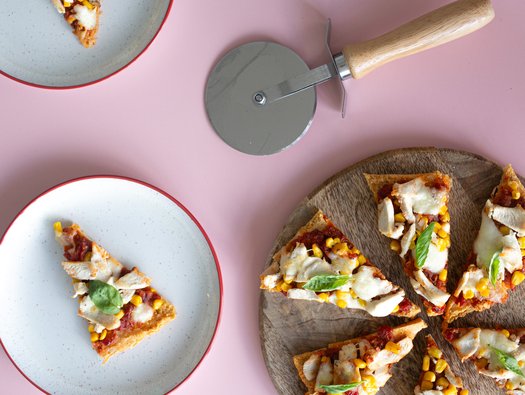Lentil pizza with chicken and sweetcorn

A pizza with a twist. This lentil base is tasty and versatile, high in fibre, low in salt, potassium and phosphate.

A pizza with a twist. This lentil base is tasty and versatile, high in fibre, low in salt, potassium and phosphate.
250g red lentils, soaked for 1 hour then drained and rinsed
100ml cold water
1 teaspoon garlic, crushed
1 teaspoon dried oregano or basil
1 teaspoon cornflour
1 dessertspoon olive oil
1 onion, peeled & finely chopped
2 garlic cloves, peeled & finely chopped
1 teaspoon dried oregano or basil
1 tablespoon tomato purée
200g tin chopped tomatoes
150g cooked chicken breast, shredded
100g sweetcorn, frozen (defrosted) or tinned (drained)
150g mozzarella, ripped into pieces
100g gem lettuce
50g cucumber, diced
½ red pepper, deseeded and sliced
100ml olive oil
1 tablespoon Dijon mustard
1 tablespoon white wine vinegar
Preheat the oven to 200°C / 180°C fan / gas mark 5. Add all the base ingredients to a food processor and blend until smooth.
Line a baking tray with greaseproof paper. Pour the lentil base mix onto the tray, smooth out into a pizza base of approximately 25cm in diameter or on a rectangular tray (approximately 25cm x 18cm). Cook for 15 minutes, remove from the oven, flip over and return to oven for a further 5 minutes.
Once the lentil base is cooked, spread the tomato sauce over the base and add the toppings. Put back into the oven for a further 5 to 10 minutes until the cheese has melted and turned golden.
Combine the salad dressing ingredients and stir or whisk together. Pour the dressing over the salad.
Remove the pizza from the oven and serve with the prepared salad.
The lentils are the main source of carbohydrate in this recipe, and the value has been provided for those who have been trained in insulin adjustment.
Despite the use of some high potassium ingredients, such as tomatoes, this recipe is low in potassium, when following the quantities in the ingredients, and the serving sizes. However, if you want to lower the potassium further you could soak the red lentils overnight, drain before cooking.
This recipe is also low in phosphate, however it does contain some phosphate, mainly provided by the chicken and lentil, although the phosphate in the lentils is not fully absorbed by the body. If you have been prescribed a phosphate binder you should take as directed. To lower the phosphate in this recipe, you could replace the chicken with more vegetables such as peppers.
This recipe is high in protein due to the lentils, a protein rich plant food, therefore suitable for those advised to eat more protein, such as those receiving dialysis.
This recipe isn't vegetarian/vegan, however toppings can be altered to create a vegetarian/vegan pizza.
This dish is best eaten freshly made.
Charlie often makes the lentil base and uses it as a pitta with dips.
Serving sizes are based on adult portions. Here is a guide for children.
Toddler (age 1-4): ¼ an adult’s portions
Young child (age 5-9): ½ an adult’s portion
Older child (age 10-12): ¾ an adult’s portion
Teenagers: Adult portions
Some children do have bigger appetites than others. If you find these suggested portion sizes too big or too small, then you may need to adjust your child’s portion to a similar amount they would usually eat at a mealtime. We would advise speaking with your dietitian before increasing the serving size if your child has been asked to reduce the potassium or phosphate in their diet.
Kidney Kitchen renal dietitian Angeline Taylor explains how eating more plant foods can help you stay well when you are living with chronic kidney disease (CKD).
You can enjoy a wide variety of delicious and healthy food when you are living with kidney disease. All Kidney Kitchen recipes are analysed and approved by kidney dietitians. Search through our kidney-friendly recipes or filter them by category below.
A classic homemade Hawaiian pizza recipe that is then shaped into ‘pumpkins’ for a Halloween theme. Making the pumpkin parcels is fiddly, so do take your time and ensure the pizza filling is as dry as possible.
By giving us your email address, you're giving us permission to send you the latest news from Kidney Care UK. Further information about how we protect and use your personal data is available in our Privacy policy. If you would like to change the way we communicate with you at any time please email [email protected]. You can unsubscribe at any time by using the link at the bottom of every email we send.